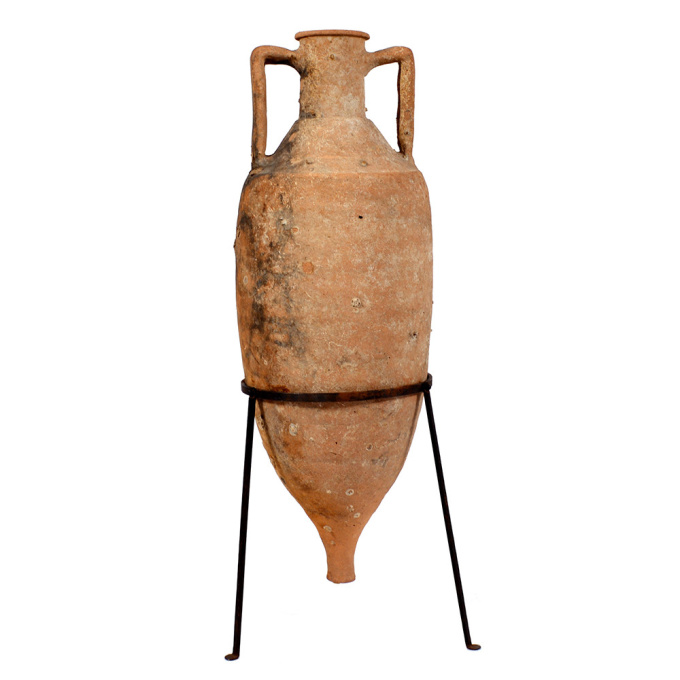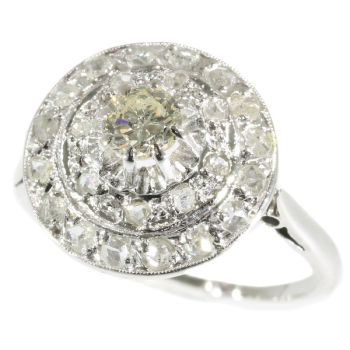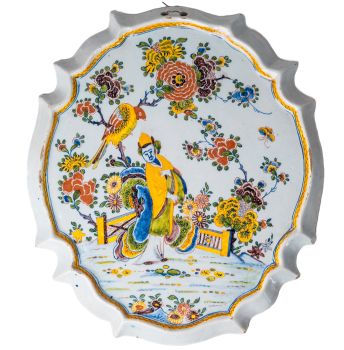Amphore romaine de transport de vin en terre cuite naufragée 100 BC - 100 AD
Artiste Inconnu
Terre cuiteCéramique
91 cm
Actuellement indisponible via Gallerease
- Sur l'oeuvre d'art
This amphora type was based on prototypes from the Aegean island of Cos (Koan type). It has a simple ring-like rim with circular section, and a straight neck ending in a marked shoulder. With a cylindrical body and a solid cylindrical spike. The handles, which comprise two parallel clay shafts with a characteristic bifid section, are flexed and join the amphora immediately below the rim and on the shoulder close to its junction with the neck. With some marine encrustation to one side from long-term underwater exposure, while the other side was most likely submerged in sand and therefore protected. The amphora is fully intact and offered including stand. 91 cm (h) Type: Dressel 2-4 Italian; Koan amphora; Peacock & Williams 10 Ex German private family collection, owned since the 1950s The precise origin of domestic viticulture and winemaking in Rome has not been determined. Early Roman culture was sharply influenced by the ancient Greeks, which makes it likely that the Mycenaean Greeks had some influences in the Roman wine culture through early settlements in southern Italy. Because the ancient Greeks saw wine as a staple of domestic life and a viable economic trade commodity, their settlements were encouraged to plant vineyards for local use and trade. Southern Italy’s abundance of indigenous vines provided an ideal opportunity for wine production Wine had religious, medicinal and social roles that set it apart from other Roman cuisine. Wine, like in Greek culture was mixed with water, and both cultures held banquets, where wine was used to show off wealth and prestige. As Rome entered its golden age of winemaking and the era of expansion, a “democratic” approach to wine started to emerge. Wine was increasingly viewed as a necessity of everyday life rather than simply a luxury enjoyed by the elite. It became available to slaves, peasants and aristocrats, men and women alike. The widespread planting of grapes ensued from the need to serve all classes of society, but was also given impetus by the changing Roman diet. In the 2nd century BC, Romans began to shift from meals consisting of moist porridge and gruel to those more bread-based; wine aided in eating the drier food.
- Sur l'artiste
Il peut arriver qu'un artiste ou un créateur soit inconnu.
Certaines œuvres ne doivent pas être déterminées par qui elles sont faites ou elles sont faites par (un groupe d') artisans. Les exemples sont des statues de l'Antiquité, des meubles, des miroirs ou des signatures qui ne sont pas claires ou lisibles, mais aussi certaines œuvres ne sont pas signées du tout.
Vous pouvez également trouver la description suivante :
•"Attribué à …." A leur avis probablement une oeuvre de l'artiste, au moins en partie
•« Atelier de …. ou « Atelier de » À leur avis, une œuvre exécutée dans l'atelier ou l'atelier de l'artiste, éventuellement sous sa direction
•« Cercle de… ». A leur avis une oeuvre de la période de l'artiste témoignant de son influence, étroitement associée à l'artiste mais pas forcément son élève
•« Style de … ». ou "Suiveur de ...." Selon eux, une œuvre exécutée dans le style de l'artiste mais pas nécessairement par un élève ; peut être contemporain ou presque contemporain
•« Manière de… ». A leur avis une oeuvre dans le style de l'artiste mais d'une date plus tardive
•"Après …." A leur avis une copie (quelle qu'en soit la date) d'une oeuvre de l'artiste
•« Signé… », « Daté… ». ou « Inscrit » À leur avis, l'œuvre a été signée/datée/inscrite par l'artiste. L'ajout d'un point d'interrogation indique un élément de doute
• "Avec signature ….", "Avec date ….", "Avec inscription …." ou "Porte signature/date/inscription" à leur avis la signature/date/inscription a été ajoutée par quelqu'un d'autre que l'artiste
Artwork details
Related artworks
- 1 - 4 / 12
- 1 - 4 / 13
Klaas II Mobach
Hanna Mobach, daughter of the sculptor Klaas Mobach, reading1950 - 1970
Prix sur demandeKunsthandel Pygmalion
Klaas II Mobach
Hanna Mobach, daughter of the sculptor Klaas Mobach, reading1950 - 1970
Prix sur demandeKunsthandel Pygmalion
1 - 4 / 24

















































